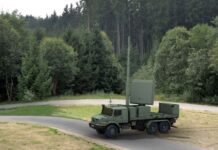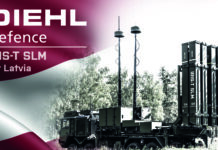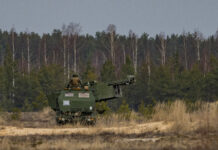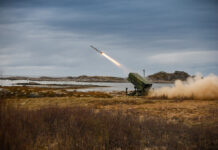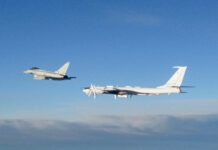The threat from Russia, which has existed for a number of years, has forced Lithuania, Latvia and Estonia to increase their defence spending. Now, as a result of the full Russian aggression on Ukraine, military modernisation is even more vital.
Cause for Modernisation
These three small Baltic States have no other option than to arm themselves, as they are the most vulnerable NATO member countries. Despite financial challenges, only increased by the COVID pandemic, they have all recently committed not to reduce their defence spending below 2 per cent of GDP.
“The spread of the virus has not changed our geopolitical location nor the conventional threats we face, meaning that defence spending, which has only recently begun to rise in Europe, cannot be undermined and must be maintained in absolute terms”, explained Estonian Defence Minister Jüri Luik in May 2020. Russia’s aggression on Ukraine only makes their commitment stronger.
Lithuania, Latvia and Estonia have each increased their modernisation efforts since 2014, when Russia invaded Ukraine for the first time. Each State has its own problems and vulnerabilities, which affects modernisation priorities. For instance, Estonia – with a defence budget worth €748M this year (2.31 per cent of GDP) – is the most northern, which means that NATO support would be the greatest challenge. Latvia – with a defence budget of €669M (2.27 per cent of GDP) this year – is located between Lithuania and Estonia and has the shortest border with Russia, but is also a neighbour of Kremlin’s puppet, Belarus. A major defence issue for Lithuania – whose defence budget this year is worth €1.2Bn (2.05 per cent of GDP and projected at 2.5 per cent by 2030) – is that it is sandwiched between Russia (Kaliningrad Oblast) and Belarus. Moreover, in case of war, Lithuania would be an obvious target since it connects the Baltic States with other NATO members (sharing a land border with Poland).
The Current Situation
All three Baltic States have relatively modest naval forces, which are mainly responsible for securing territorial waters and Exclusive Economic Zones (EEZ). Fleets are based mostly on used ships, either donated by partner states or procured for a symbolic amount. The longest seashore is in Estonia (1,241 km or 3,800 km if islets are included), while Latvia has less than 500 km and Lithuania just 100 km. Their air forces are also small – none of the Baltic States have any combat aircraft and there are no plans to procure them, both due to financial and operational reasons. Their skies are protected under the NATO Baltic Air Policing mission (with bases in Estonia and Lithuania). The air forces of all three Baltic States are responsible mainly for:
- airspace surveillance
- control duties,
- air support,
- transportation
- SAR assistance
Lithuania
The Lithuanian military has a very special role, because during an armed conflict it would have to protect the narrow strip of the so-called Suwalki Gap, which is arguably NATO’s most fragile hotspot, connecting the Baltic States with Poland and the rest of NATO territory. In order to defend it efficiently, the Geležinis Vilkas (Iron Wolf) Mechanised Brigade – which is Lithuania’s elite unit – was assigned to NATO’s Multinational Division North East headquarters. This unit has been closely cooperating with the Polish 15th Mechanised Brigade.
A top priority for the Lithuanian Land Forces is the full integration of the 88 BOXER (8×8) vehicles (codenamed VILKAS), armed with Rafael SAMSON Mk II RCWS, an Orbital ATK MK44 30 mm gun and Rafael SPIKE LR ATGMs. The final batch is due to be delivered this year, which means a one-year delay due to technical defects and the COVID-19 pandemic. This represents the largest procurement contract in Lithuanian history. Vehicles were officially handed over in 2019 and are now being integrated by the Geležinis Vilkas Brigade in Rukla and Alytus. No decisions have yet been made, but Lithuania has been considering a replacement of its tracked M113s earlier than previously planned (in 2030).
In early 2016, Vilnius ordered 340 Daimler AG’s Unimog U5000S 5-tonne capacity trucks for €70M. The last batch was handed over in late 2020 with deliveries allowing Lithuania to phase out their older Unimog trucks. The Lithuanian Army’s experience with new vehicles was positive enough to make another request – all 42 U5000s from the second batch were delivered in late 2021. They were all procured through the NATO Support and Procurement Agency (NSPA). The U5000s increase the Lithuanian Army’s mobility, which use them for various logistical tasks. More procurements are planned in the near future – of the heavier (5-10 tonne) trucks.
As part of the deep modernisation of its transport fleet, in late 2020, for roughly €10M, Lithuania ordered 25 special purpose AROCS trucks (16-tonnes) for the transportation of PzH 2000 ammunition, containers, vehicles, equipment and other military supplies. Another acquisition underway is for used vehicles of different purposes – Mercedes-Benz all-terrain vehicles, DAF trailers and trucks, trawls, spare trailers, etc. – on a bilateral basis from the Netherlands Armed Forces. Modernisation efforts also include eight Daimler AG’s ZETROS 3643 off-road capacity heavy duty trucks, which can transport heavy (up to 70 tonnes) vehicles, such as PZ2000 SPHs, or Bergepanzer-2 armoured recovery vehicles. The 3643s will be deployed to the General Romualdas Giedraitis Artillery Battalion and the Logistics Battalion of the Geležinis Vilkas Brigade.
Another priority of the Lithuanian Army is to enhance the high-mobility capability of its mechanised infantry, which need bigger vehicles than the HMMWV multirole light trucks already in service. In order to achieve this goal, Vilnius decided to procure 200 joint light tactical vehicles (JLTV) for €142M between 2020-2024. The first batch of 50 vehicles was handed over to the Geležinis Vilkas Brigade in Rukla in January 2021. Vehicles will be deployed to the Žemaitija Brigade, which was formed in 2016 in western Lithuania.
Efficient fire support is another key priority. In 2015, Vilnius ordered 21 ex-German PzH 2000 155 mm SPHs. The first batch was handed over in December 2018 and are now used by the General Romualdas Giedraitis Artillery Battalion of the Geležinis Vilkas Brigade. It is important to underscore that 16 operational howitzers were slightly upgraded by Germany’s KMW before their transfer to Lithuania (for €10.5M, with the remaining five used for training and spare parts). Vehicles were equipped with more advanced fire control software and an improved battle management system.
This is a major boost for Lithuania, which previously had to rely on towed M101A1 105 mm guns. The PzH 2000s offer more mobility, fire precision and much longer range (40 km compared to 11 km of the towed howitzers). More modernisation efforts are planned. In January 2022, it was officially confirmed that Vilnius wants to boost its capabilities with another procurement – this time with a ground-based multiple launch rocket system. The supplier has not yet been announced, but it was revealed that this initiative will be carried out in coordination with Latvia and Estonia – in December 2021, the Baltic States agreed to buy similar systems.
Most likely, they will select the High Mobility Artillery Rocket System (HIMARS) from the United States (such a preference was announced by Chief of Defence Lieutenant General Valdemaras Rupsys in 2022). Due to increased tensions with Russia, Vilnius decided to speed up the procurement process – while previously it was expected to purchase the MLRS by 2028, the date is now 2026. The contract is expected to be signed this year.
Air defence is also among Lithuanian modernisation priorities. In June 2020, Vilnius received the NASAMS medium-range system. In total, Vilnius is procuring two NASAMS batteries (four launchers) for its air force. Just like other Baltic States, Lithuania is also enhancing its anti-tank capabilities. In January 2022, Vilnius signed an agreement with Saab for a delivery of the Carl Gustaf M4 (84 mm) recoilless rifles (man-portable and reusable). This deal is worth roughly EUR 14M and will allow Lithuania to phase out the previous generation of the Carl-Gustaf launchers, which has been in service since the 1990s. At the same time, the US State Department gave the green light to a potential sale of the FGM-148F JAVELIN ATGMs. Lithuania has been using JAVELINs since 2001 and recently requested an additional 341 missiles with 30 launchers.
Lithuania has also identified some naval priorities. Apart from a recent acquisition of navigation radars with air target detection and tracking capability for four patrol boats (P11 ŽEMAITIS, P12 DZŪKAS, P14 AUKŠTAITIS and P15 SĖLIS), Vilnius is also procuring a third ex-British HUNT class mine countermeasures vessel (former HMS QURON). There is still one naval programme to be completed: Lithuania wants to acquire a new Safety and Rescue Exercise (SAREX) ship. Four UH-60M aircraft, ordered in 2020 for EUR181M, will replace the currently used and obsolete Russian-made Mi-8 helicopters and bring Lithuania closer to NATO standards.
Estonia
Estonia’s modernisation priorities were adopted in the 2031 development plan national defence, which was approved by the Government in December 2021. It is planned to increase wartime manpower levels from 24,200 to 26,700 soldiers with an additional 4,000 in reserve. Among the technical priorities included are, among others, mobile naval radars with a joint (among Baltic States) radar picture. Territorial defence, anti-tank capabilities (for all infantry brigades) and general situational awareness, and battle command are to be enhanced. Between 2024-2025 Estonia will establish two radar sites. As a result of the Russian aggression against Ukraine, Estonia urgently ordered 5,942 Spanish C90-CR-RB grenade launchers. In January, 500 Spike-SR ATGMs, as a replacement of the Pv-1110 towed 90 mm recoilless guns, were purchased.
The most important modernisation effort of the Estonian Land Forces during a previous budget period was a procurement of 44 CV9035 AIFVs for its reconnaissance (scout) battalions, along with six LEOPARD 1-based support vehicles. Last year, two local companies – Scania Eesti AS and AS Ühenenud Depood – were awarded a contract worth EUR 30M to reconfigure 37 CV90s. They will be adapted for combat engineer and anti-tank roles. Vehicles will have improved night-driving capabilities and increased turret protection. This is the biggest order placed in the Estonian defence industry to date.
Additionally, the 2nd Infantry Brigade is expected to be equipped with new armoured vehicles. Estonia, which has 70 XA-188 and 56 older XA-180 APCs, planned to procure them earlier, but this was postponed until 2025-2030. Thanks to a planned modernisation effort, the XA-188 will remain in service until 2048, and the XA-180 until 2028. Estonia also wants to replace the machine guns and Carl Gustaf anti-tank weapons.
Fires
Regarding artillery, Estonia also decided to upgrade its equipment, which is now composed of legacy 155 mm FH-70 towed howitzers (24 supplied by Germany) and 18 ex-German/Finnish D-30 122 mm guns (the latter howitzers Estonia wanted to donate to Ukraine). A total of 18 ex-South Korean K9 THUNDER SPHs will serve for approximately 30 years. The first trials of now operational K9s were carried out by the Estonian Army in early 2021. As explained by Estonian Eesti Rahvusringhääling news agency, “the procurement and acquisition ties in with Ministry of Defence doctrine for the next few years, which will include a focus on developing EDF artillery capabilities, in addition to fully mechanising both the EDF’s infantry brigades, and setting up coastal defence systems which will include missile systems and sea mines”.
As mentioned earlier, Estonia joined Lithuania and Latvia in a regional effort to procure MRLS artillery. It was explained by Tallinn that “an MLRS system makes it possible to attack high-value targets that are very far away. The system is used in fire and move-type tactical situations to avoid counter-fire. The weapons system can use long-range high-precision munitions”. As noted by a Poland-based OSW (Centre for Eastern Studies), “Estonia is moving to the next stage in the development of its armed forces. After a period of investment in the basic systems for the land forces, whose task is to delay enemy forces until allied reinforcements arrive, Estonia wants to develop longer-range capabilities”.
On top of Estonia’s defence budget, projected through 2026, is a coastal defence system with anti-ship missiles and naval mines. Tallinn plans to carry this out jointly with Latvia. Estonia has already completed identifying needs and conducted a market survey. It is expected that an Estonian-Latvian system (or only Estonian) will have an operational range of at least 300 km, and could – as explained by head of the Estonian Defence Forces Lt. Gen. Martin Herem – “support combat operations on each other’s territories, as well as to influence military capabilities which could prevent the arrival of allies”. The project cost is estimated at EUR 46M. So far, in October 2021, Estonia signed a contract with Singaporean-Israeli company Proteus Advanced Systems for the purchase of BLUE SPEAR 5G anti-ship missiles. Regarding mines, they were ordered last year from an unnamed Finnish company. When accomplished, both projects will significantly bolster Estonia’s coastal defence.
Latvia
Latvian modernisation efforts are very small, even when compared with other Baltic States. No wonder – its defence budget is the lowest and its military is lightly armed. For 2022, Riga allocated €758M for defence, while 32 per cent of this amount is to be devoted to investments (not only technical modernisation). Already in January, Defence Minister Artis Pabriks underlined a need to spend 2.5 per cent of GDP in the next three years. However, before an increase, Latvia expects a reduction to €748M in 2023 (2.07 per cent of GDP).
Modernisation has been carried out within principles set in the National Defence Concept 2020-2024. One of the most important goals is to increase Latvian interoperability with its NATO allies and to encourage greater voluntary participation in the National Guard, which is expected to grow to at least 10,000 troops by 2024. Investment priorities include the following: indirect fire support, air defence, mechanisation, tactical air transportation, command management, combat engineers, special operations units, as well as the support capabilities of the receiving state (HNS).
Mechanisation
While Lithuania has already boosted its mechanised infantry with new vehicles, Latvia is still in a middle of the whole process. Previously, Latvia wanted light and medium 4×4 tactical vehicles. A total of 12 companies submitted their proposals and finally the one made by Sisu Auto (with GTP 4×4) was selected. However, in June 2020 Latvia switched its interest to 6×6 armoured vehicles. The project was initially carried out with Estonia and Finland, but last year Tallinn opted out due to mounting costs. Finally, in late October 2021, Riga received the first four 6×6 Patria wheeled APCs. Deliveries are planned to finish in 2029. Latvia, which does not have any infantry fighting vehicles, ordered more than 200 PATRIA for roughly €200M. This is the largest modernisation effort in Latvian history. An interesting plan was announced in February 2022 by Latvia and Estonia, who want to find a partner able to supply both countries with vehicles of 16 different types over the next ten years (both vehicles of a load capacity up to 5 tonnes and above). A declared contract value is EUR 693M.
Latvia does not want to lag behind its Baltic allies in terms of artillery. The Latvian Army is now accepting the M109A5Ö SPHs (modernised A2/A3 variant with 155 mm/39-calibre M185 barrel), which were procured along driver training platforms and a mobile tactical control centre. In total, 47 used vehicles were ordered in Austria, which received them in 1994 from the United Kingdom. They were upgraded between 2003-2007 and kept in storage.
It is reported that Latvia is now looking to boost its small Air Force, composed of An-2 transport aircraft and Mi-17 helicopters, with tactical UAVs both for reconnaissance and even strike roles. No details have been made public, but Riga showed some interest in the Bayraktar TB2 drones from Turkey – an official Latvian delegation visited the Baykar National UAV R&D and Production Centre last year. Regarding confirmed modernisation efforts, Riga ordered four UH-60M BLACK HAWK helicopters for EUR 175M (deliveries are expected this year) and two locally manufactured ultra-light PELEGRIN TARRAGON trainer aircraft.
Future Plans
Although all three Baltic States have their own, unique capabilities and needs, it is possible to identify some similarities. All are interested in future enhancing general mobility, anti-tank capabilities within mechanised infantry, as well as in improving air defence (with MANPADS and short-range systems). An important and symptomatic change among all three Baltic States is an attempt to acquire long-range strike capabilities (artillery), which can serve as a conventional deterrence. When finally procured and introduced, such systems will increase their capability to influence the enemy with indirect fire from a distance.
There is no doubt that Latvia, Lithuania and Estonia will closely analyse Russian doctrine and tactics used against Ukraine. Their conclusions will shape future modernisation efforts, which will then be revised. Some projects will be sped up (light arms, anti-tank systems, air defence, communications), while others will be added (various UAVs, surveillance and reconnaissance). Moreover, military stocks have to be re-supplied as soon as possible, since the Baltic States has assisted Ukraine by supplying arms. Lithuania donated STINGER MANDPADs, some light arms with ammunition, bulletproof vests. Latvia also delivered STINGERs, while Estonia sent JAVELIN ATGMs.
We might also expect more integration, including in terms of interoperability, among the Baltic States and with other NATO partners. Some attempts – for instance joint military procurements – have already been made, but so far, they have proved too successful. A potentially important milestone was reached last year. First, in May, they agreed to tighten their defence cooperation. Then, in December, the Governments in Vilnius, Riga and Tallinn agreed to create a joint Baltic operational area to coordinate defence.






